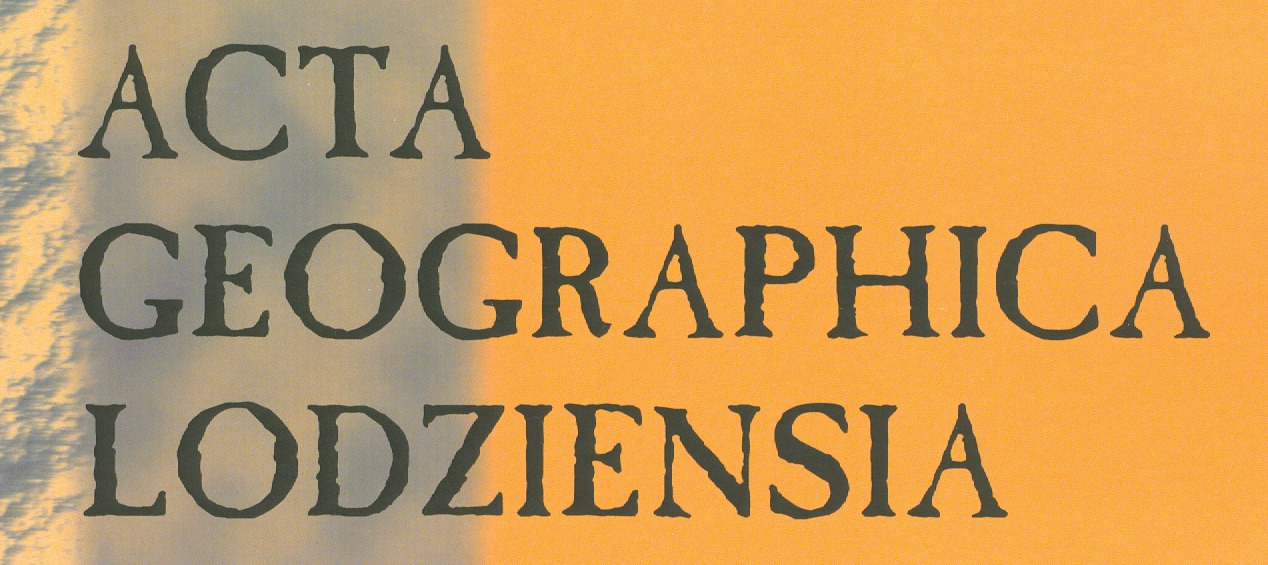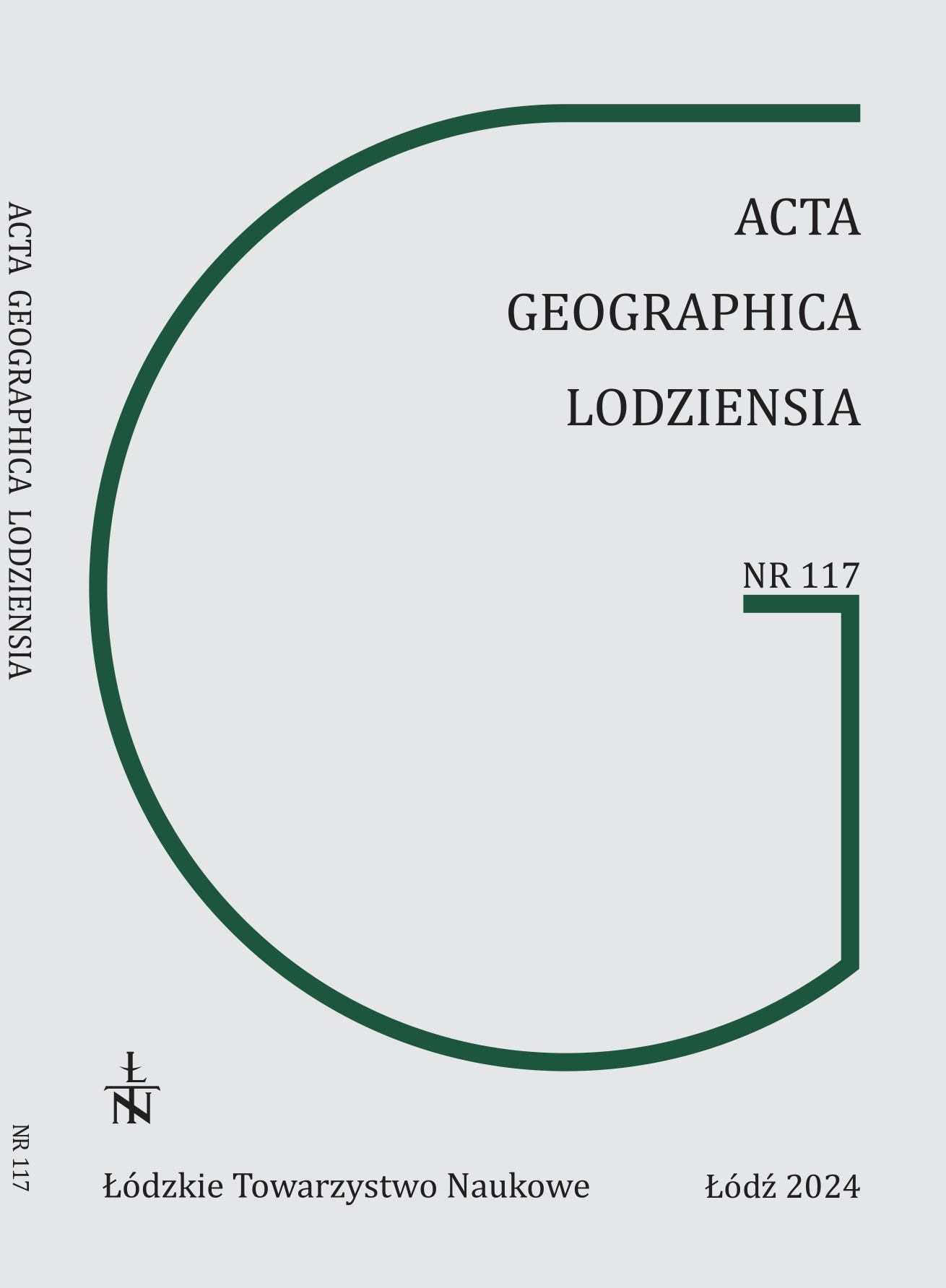Very warm and tropical nights in voivodeship cities in Poland in the period 1971–2020
DOI:
https://doi.org/10.26485/AGL/2024/117/4Słowa kluczowe:
minimum temperature, city, variability, trends, climate changeAbstrakt
Using minimum air temperature data for the period April–September 1971–2020 obtained from 16 meteorological (synoptic) stations of IMGW-PIB located within the administrative boundaries of voivodeship cities in Poland, the temporal and spatial distribution of very warm (from >18°C to ≤20°C) and tropical (>20°C) nights was determined. The paper presents the results for thirty-year-long reference periods (1971–2000, 1981–2010, 1991–2020). A positive trend of mean minimum air temperature in all stations in each month of the period April–September was demonstrated, and was particularly pronounced in 1991–2020. Since 2010, there has been a considerable increase in the number of very warm and tropical nights, most evident in Gdańsk and Gorzów Wielkopolski. It was found that very warm and tropical nights occur most frequently as isolated cases, rarely in a series of two or three nights, and particularly rarely in a series of six and more episodes. The longest series of thermally characteristic nights was found in Warszawa in 2018 between 25 July and 5 August. Based on the earliest and latest dates, it was found that, in the analysed years, very warm and tropical nights occur earlier but also disappear later.
Bibliografia
AMS. 2024. 2020 Weather & Environmental Terms Glossary. Glossary – NOAA National Weather Service. Online: http://wilmingtonweather.net/wp-content/uploads/2020/01/We ather-Terms-Glossary-1-5-2020.pdf (last accessed: 05.07.2024).
Alexander L.V., Zhang X., Peterson T.C., Caesar J., Gleason B., Klein Tank A.M.G., Vazquez‐Aguirre J.L. 2006. Global observed changes in daily climate extremes of temperature and precipitation. Journal of Geophysical Research: Atmospheres 111(D5).
Arguez A., Vose R.S. 2011. The definition of the standard WMO climate normal: The key to deriving alternative climate normals. Bulletin of the American Meteorological Society 92(6): 699-704.
Bartoszek K., Węgrzyn A., Sienkiewicz E. 2014. Częstość występowania i uwarunkowania cyrkulacyjne nocy ciepłych, bardzo ciepłych oraz gorących w okolicach Lublina i Nałęczowa. Przegląd Naukowy – Inżynieria i Kształtowanie Środowiska 66: 410-420.
Bednorz E., Czernecki B., Półrolniczak M., Tomczyk A.M. 2018. Atmospheric forcing of upwelling along the south-eastern Baltic coast. Baltica 31(1).
Bielec-Bąkowska Z., Piotrowicz K. 2013. Temperatury ekstremalne w Polsce w latach 1951– –2006. Prace Geograficzne 132: 59-98.
Błażejczyk K., Kuchcik M., Milewski P., Dudek W., Kręcisz B., Błażejczyk A., Pałczyński C.M. 2014. Miejska wyspa ciepła w Warszawie: uwarunkowania klimatyczne i urbanistyczne. Wyd. Akademickie SEDNO, Warszawa.
Błażejczyk K., Twardosz R., Wałach P., Czarnecka K., Błażejczyk A. 2022. Heat strain and mortality effects of prolonged central European heat wave – an example of June 2019 in Poland. International Journal of Biometeorology 66: 149-161.
Cantos J.O., Serrano-Notivoli R., Miró J., Meseguer-Ruiz O. 2019. Tropical nights on the Spanish Mediterranean coast 1950–2014. Climate Research 78(3): 225-236.
Casanueva A., Burgstall A., Kotlarski S., Messeri A., Morabito M., Flouris A.D., Nybo L., Spirig C., Schwierz C. 2019. Overview of Existing Heat-Health Warning Systems in Europe. International Journal of Environmental Research and Public Health, 16(15): 2657.
Christensen O.B., Yang S., Boberg F., Fox Mau-le C., Thejll P., Olesen M., Drews M., Jomo H., Sørup D., Christensen J.H.. 2015. Scalability of regional climate change in Europe forhighend scenarios. Climate Research 64: 25-38.
Climate Adapt. The European Climate Adaptation Platform Climate-ADAPT, Tropical Nights, 2011–2099. Online: https://climate-adapt. eea.europa.eu/en/metadata/indicators/tropic-al-nights-2011-2099 (last accessed: 05.07.2024)
Dailidienė I., Servaitė I., Dailidė R., Vasiliauskienė E., Rapolienė L., Povilanskas R., Valiukas D. 2023. Increasing Trends of Heat Waves and Tropical Nights in Coastal Regions (The Case Study of Lithuania Seaside Cities). Sustainability 15(19): 14281.
ETCCDI. 2023. Climate change indices. Online: http://etccdi.pacificclimate.org/indices.shtml (last accessed: 08.07.2024).
Gabriel K., Endlicher W. 2011. Urban and rural mortality rates during heat waves in Berlin and Brandenburg. Germany. Environmental Pollution 159: 2044-2050.
Graczyk D., Pińskwar I., Choryński A., Szwed M., Kundzewicz Z. 2017. Zmiany temperatury powietrza w Polsce. In: Z.W. Kundzewicz, O. Hov, T. Okruszko (eds.) Zmiany klimatu i ich wpływ na wybrane sektory w Polsce. Instytut Środowiska Rolniczego i Leśnego Polskiej Akademii Nauk, Poznań: 47-59.
IPCC. 2023. Climate Change 2023: Synthesis Report. Contribution of Working Groups I, II and III to the Sixth Assessment Report of the Intergovernmental Panel on Climate Change. IPCC, Geneva, Switzerland: 35-115. DOI: 10.59327/IPCC/AR6-9789291691647
Jacob D., Kotova L., Teichmann C., Sobolowski S.P., Vautard R., Donnelly C., Koutroulis A.G., Grillakis M.G., Tsanis I.K., Damm A., Sakalli A., van Vlie M.T.H. 2018. Climate impacts in Europe under +1.5C global warming. Earth's Future 6(2): 264-285.
Kejna M., Rudzki M. 2021. Spatial diversity of air temperature changes in Poland in 1961–2018. Theoretical and Applied Climatology 143(3–4): 1361-1379.
Klok S., Kornus A., Kornus O., Danylchenko O., Skyba O. 2023. Tropical nights (1976–2019) as an indicator of climate change in Ukraine. In: IOP Conference Series: Earth and Environmental Science 1126(1), IOP Publishing: 012023.
Kossowska-Cezak U. 2014. Zmiany wieloletnie liczby termicznych dni charakterystycznych w Warszawie (1951–2010). Prace Geograficzne 136: 9-30.
Kossowska-Cezak U. 2016. Ekstremalne maksimum czyli arogancja ignorancji. Przegląd Geofizyczny 59(1–2): 109-115.
Kozłowska-Szczęsna T., Krawczyk B., Kuchcik M. 2004. Wpływ środowiska atmosferycznego na zdrowie i samopoczucie człowieka 4. Polska Akademia Nauk – Instytut Geografii i Przestrzennego Zagospodarowania, Warszawa, Poland.
Koźmiński C., Michalska B. 2008. Zmienność minimalnej dobowej temperatury powietrza w strefie polskiego wybrzeża Bałtyku. Acta Agrophysica 12(3).
Krzyżewska A., Wereski S., Demczuk P. 2019. Biometeorological conditions during an extreme heatwave event in Poland in August 2015. Weather 75(6): 183-189.
Krzyżewska A., Dobek M., Domżał-Drzewicka R., Rząca M. 2015. Upały a zdrowie i życie człowieka na przykładzie Lublina. In: A. Wdowiak, A. Tucki (eds) Aspekty środowiskowo-rekreacyjne i prawne zdrowia człowieka. Międzynarodowe Towarzystwo Wspierania i Rozwoju Technologii Medycznej, Włodawa: 39-51.
Kuchcik M. 2017. Warunki termiczne w Polsce na przełomie XX i XXI wieku i ich wpływ na umieralność 263. Polska Akademia Nauk – Instytut Geografii i Przestrzennego Zagospodarowania, Warszawa, Poland.
Laaidi K., Zeghnoun A., Dousset B., Bretin P., Vandentorren S., Giraudet E., Beaudeau P. 2012. The impact of heat islands on mortality in Paris during the August 2003 heat wave. Environmental Health Perspectives 120(2): 254-259.
Liu X., He B., Guo L., Huang L., Chen D. 2020. Similarities and differences in the mechanisms causing the European summer heat-waves in 2003, 2010, and 2018. Earth's Future 7: e2019EF001386.
López-Bueno J.A., Navas-Martín M.Á., Díaz J., Mirón I.J., Luna M.Y., Sánchez-Martínez G., Linares C. 2021. The effect of cold waves on mortality in urban and rural areas of Madrid. Environmental Sciences Europe 33(1): 1-14.
Marsz A., Styszyńska A. 2022. Przebieg temperatury powietrza w Polsce w latach 1931–2020: zmiany antropogeniczne czy naturalne? Automatyka, Elektryka, Zakłócenia 13 1(47): 44-52.
Matuszko A., Mikołajczyk D., Matuszko D. 2023. Zmiany klimatu Krakowa i adaptacja do nich w kontekście uwarunkowań planistycznych. Prace Geograficzne 170: 99-118.
Mąkosza A., Rawicki K. 2018. The multiannual variability in the occurrence of the temperature indices in the Pyrzycko-Stargardzka plain mesoregion. Folia Pomeranae Universitatis Tech-nologiae Stetinensis. Agricultura, Alimentaria, Piscaria et Zootechnica 340(45)1: 65-76.
Michalska B. 2011. Tendencje zmian temperatury powietrza w Polsce. Prace i Studia Geograficzne 47: 67-75.
Morabito M., Crisci A., Messeri A., Messeri G., Betti G., Orlandini S., Raschi A., Maracchi G. 2017. Increasing Heatwave Hazards in the Southeastern European Union Capitals. Atmosphere 8(7): 115.
Morak S., Hegerl G.C., Kenyon J. 2011. Detectable regional changes in the number of warm nights. Geophysical Research Letters 38(17): L17703.
Murage P., Hajat S., Kovats R.S. 2017. Effect of night-time temperatures on cause and agespecific mortality in London. Environmental Epidemiology 1(2): e005.
Niedźwiedź T. (red.). 2003. Słownik meteorologiczny. Polskie Towarzystwo Geofizyczne, Instytut Meteorologii i Gospodarki Wodnej – Państwowy Instytut Badawczy, Warszawa.
Peterson T.C. 2005. Climate Change Indices. WMO Bulletin 54(2): 83-6.
Rippstein V., de Schrijver E., Eckert S., Vicedo-Cabrera A.M. 2023. Trends in Tropical Nights and their Effects on Mortality in Switzerland across 50 years. PLOS Climate 2(4): e0000162.
Schär C., Vidale P.L., Lüthi D., Frei C., Häberli C., Liniger M.A., Appenzeller C. 2004. The role of increasing temperature variability in European summer heatwaves. Nature 427: 332-336.
Skrzyńska M., Twardosz J. 2023. Long-term changes in the frequency of exceptionally cold and warm months in Europe (1831–2020). International Journal of Climatology 43: 2339-2351.
Tomczyk A.M. 2018. Impact of atmospheric circulation on the occurrence of hot nights in Central Europe. Atmosphere 9(12): 474.
Twardosz R., Wałach P. 2020. Niezwykle ciepła pogoda w czerwcu 2019 roku w Polsce i jej przyczyny cyrkulacyjne. Przegląd Geofizyczny, (3-4): 179-194.
Twardosz R., Walanus A. Guzik I. 2021. Warming in Europe: Recent Trends in Annual and Seasonal temperatures. Pure and Applied Geophysics 178: 4021-4032.
Wibig J. 2012. Has the frequency or intensity of hot weather events changed in Poland since 1950? Advances in Science and Research 8(1): 87-91.
Więcław M. 2015. Bardzo ciepłe i gorące noce w północno-zachodniej Polsce. Journal of Education, Health and Sport 12: 31-40.
WMO. 2017. Guidelines on the Calculation of Climate Normals. WMO 1203. Online: https://library.wmo.int/doc_num.php?expln- num_id=4166 (last accessed: 05.07.2024).
Vautard R., Gobiet A., Sobolowski S., Kjel-lström E., Stegehuis A., Watkiss P., Jacob D. 2014. The European climate under a 2°C global warming. Environmental Research Letters 9(3): 034006.
Yavasl D.D., Erlat E. 2024. Tropical nights in the Mediterranean: A spatiotemporal analysis of trends from 1950 to 2022. International Journal of Climatology 1: 1-17.
Pobrania
Opublikowane
Jak cytować
Numer
Dział
Licencja
Prawa autorskie (c) 2024 Łódzkie Towarzystwo Naukowe

Utwór dostępny jest na licencji Creative Commons Uznanie autorstwa – Użycie niekomercyjne – Bez utworów zależnych 4.0 Międzynarodowe.



